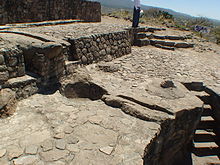Tetzcotzingo
Tetzcotzingo is a late post-classical ruin site in the Valley of Mexico, around 7 km east of Texcoco . It is located on a foothill of the Cerro Tlaloc at an altitude of around 2500 m and is freely accessible. The buildings of the Tetzcotzingo are attributed to the ruler of Texcoco, Nezahualcóyotl , who created the first landscape garden with water features in the 15th century . The first descriptions come from the colonial historian Fernando de Alva Ixtlilxóchitl from the ruling house of Teztcoco . After 1968 Jeffrey R. Parsons carried out the first inspection, exposures and reconstructions have been carried out since 1981.
The ruin site consists of three parts:
- The palace on top of the mountain
- The supply system with reservoirs and supply dams as well as connecting canals over the neighboring hills to the east
- The distribution system, consisting of two water pipes, which circled the Tetzcotzingo-Berg starting from the supply dam on its north and south sides and meet again and feed the various basins carved into the stone.
The palace
At the top of the Tetzcotzingo there are several large, stepped platforms. They may have served as the foundation for light structures, but their existence and function remain uncertain. According to other authors, it is more about dance platforms. Another building complex, known as the palace, lies below the Baño del Rey and was connected to it by a narrow steppe carved into the rock.
The supply system
From a spring located at an altitude of 2750 m around 5 km southeast of the Tetzcotzingo, the water was led to the Tetzcotzingo via channels parallel to the contour lines. Here, the Cerro Metecatl, east of the Tetzcotzingo, was almost completely circled. The water then passed through several reservoirs and basins to a large, now reconstructed aqueduct, 160 m long, leading to Cerro Tetzcotzingo. The aqueduct embankments consisted of a wide stone embankment and a narrower masonry embankment, on the crown of which the relatively narrow actual canal ran. The canals were built from unprepared stones and presumably lined with lime mortar on the inside.
Today, the water from the spring is conducted through the old canal for a length of around 1 km, then through a very long, probably also old canal that leads down to the plain.
The distribution system
At the point where the second aqueduct meets the Cerro Tetzcotzingo, the canal divides and also runs parallel to the contour lines in the south and around the mountain on the steeper north side. The canal was mostly also bricked here, but there are also smaller sections where the canal was carved into the rock. The diameter of the channel was approximately 25 x 25 cm. Distributions branched off from these canals at numerous points at regular intervals, which mostly consisted of a large stone block in which a channel was sunk. From this water could either be directed onto the slopes of the mountain, where gardens are to be assumed, or, partly staggered as cascades, into round basins carved into the rock, into which stone stairs also led. Access stairs were also carved out of the rock. These basins now have imaginative names such as Baño del Rey , Baño de la Reina , and Baño de las Concubinas (bath of the king, queen and concubines).
The Cerro Tetzcotzingo was not the only such facility. Similar systems are described for the Cerro Purificación not far to the north. There are two longer aqueducts of 375 and 400 m length and heights of up to 13 m, which are still in operation.
Individual evidence
- ↑ Jeffrey R. Parsons: Ingenería hidráulica prehispánica en Acolhuacan . In: Arqueología Mexicana 58 (2002) pp. 54-59
Coordinates: 19 ° 29 ′ 49.5 ″ N , 98 ° 49 ′ 6 ″ W.


